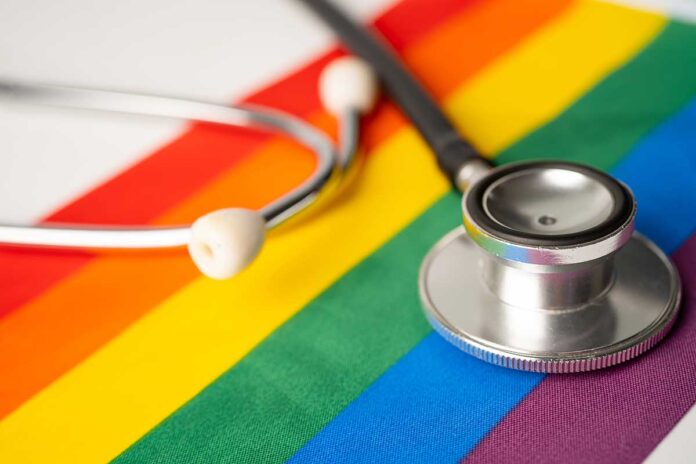Going to see a healthcare professional can be an alienating and nerve-wracking experience, particularly for those who fall outside a certain heterosexual, cisgender, white, and able-bodied idea of ‘normal.’ The lobby of my doctor’s office is covered in ads for weight loss. Over the scale in the exam room hangs a large Body Mass Index (BMI) chart with squares of green, red, and yellow, denoting “good” “bad” and “borderline” bodies. My primary care doctor asks what kind of birth control I’m on, following with, “Oh, are you the one with the partner who’s a girl?” — misgendering my wonderful nonbinary partner. This is all pretty standard and minor as it goes. It’s not exactly a hot take that our healthcare system fails many people. One particular devastating intersection of failure is seen in the health and treatment of LGBT and fat people.
Both LGBT and fat individuals are more likely to delay care due to fear of discrimination, often leading to exacerbated health issues down the line. This fear is far from groundless. Studies of healthcare professionals show a strong explicit and implicit anti-fat bias. Other studies have shown 54% of transgender respondents reporting at least some problems with healthcare providers refusing to provide services to them on the basis of their identity.
As Aubrey Gordon writes in her well researched book “What We Don’t Talk About When We Talk About Fat,” “Nearly all academic and scientific research that has looked for a link between weight stigma and ill health has found one.” Research has found that adults who encounter more weight discrimination, across BMIs, “have a 60% increased risk of death.” LGBT and fat bodies are both often seen as outside an accepted medical norm.
Living with a stigmatized body and identity has serious health implications, both mentally and physically. Greater levels of stigma are associated with greater health risks. Transgender people are more likely to experience discrimination than gay or lesbian folks. Folks with a BMI over 40 are more likely to experience discrimination than someone with a BMI of 30 (the CDC threshold of ‘obesity’). Other factors like race, dis/ability, and sex can have profound impacts as well.
As Gordon points out, “fat transgender people bear dual stigmas in medical settings.” They may be required to lose weight before gender-affirming surgery. Considering that over 40% of Americans are considered obese, this is an obstacle that many transgender folks may face. These requirements are in place despite studies showing that weight requirements for gender-affirming surgery vary greatly between providers and are not supported by data. Additionally, these requirements are based on BMI, which is not only a poor indicator of health, but is especially inaccurate when considering Black and Brown bodies.
A 2019 study at Mt. Sinai Hospital of transgender individuals pursuing gender-affirming surgery found that weight loss requirements did not see weight loss results. Not only are weight loss mandates not based on good data, but they are also ineffective in achieving weight loss. Bariatric surgery may be an option for some, but this is an invasive surgery which can have serious complications, isn’t an option for everyone, and isn’t always covered by insurance. And even if this is an option, that option is to undergo a medically unnecessary invasive surgery in order to be eligible for a gender-affirming surgery.
Of course, weight loss requirements are just one obstacle that fat LGBT folks may face. Doctors may legally refuse patients over a certain weight, or a patient’s insurance may not cover certain types of care. That’s if they have health insurance. Eighty-three percent of heterosexual adults have health insurance, compared to 78% of LGB individuals and 56% of transgender individuals. Before the Affordable Care Act passed, applicants could be denied insurance due to their weight, considered a pre-existing condition. While that is no longer legal, overweight individuals are still subject to higher premiums. Healthcare is already prohibitively expensive for many.
Part of the cause of health disparities is a lack of training among healthcare professionals. There is substantial scientific evidence illustrating that obesity is a complex condition determined by environmental, psychological, and biological factors, yet a 2021 meta-analysis confirms that perceptions of overweight and obese individuals as “lazy, incompetent, [and] lacking willpower” are deeply rooted among healthcare professionals. A 2009 study found that only “56% of physicians felt qualified to treat obesity.” Many healthcare professionals have strong biases affecting their treatment of fat patients, and they also lack critical medical understanding of overweight and obesity. Similarly, a 2017 study in the Midwest found that although 85.7% of healthcare providers were willing to provide care to transgender patients, only 68.6% felt capable, and only 52.1% were familiar with transition care guidelines. And that of course leaves 15% who were not even willing to provide care. Sixty-four percent of LGB and 83% of transgender persons reported problems finding “adequately trained/competent health professionals.”
Stigma and insufficient medical training both seriously contribute to worse health outcomes among fat and LGBT folks. But even small interventions can have an effect on lessening bias. This can be anything from a 15-minute video on medical realities of obesity, to anti-bias training, to requirements that physicians ask specific questions of all patients, rather than make assumptions. For example, asking all patients about their activity level and diet instead of making any assumptions based on weight. More research needs to be done both on how bias is affecting the health of marginalized groups like LGBT and fat folks. There also needs to be more research on what interventions are most effective and lasting. The data on both weight-related and LGBT-related competency in healthcare professionals show that both groups have a desire for better training in these areas, so the will is there. Schools and institutions have to start putting more of these trainings and interventions in place. These measures can save lives.

